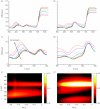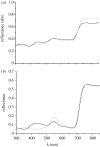Function of blue iridescence in tropical understorey plants
- PMID: 20519208
- PMCID: PMC2988267
- DOI: 10.1098/rsif.2010.0201
Function of blue iridescence in tropical understorey plants
Abstract
The blue colouration seen in the leaves of Selaginella willdenowii is shown to be iridescent. Transmission electron microscopy studies confirm the presence of a layered lamellar structure of the upper cuticle of iridescent leaves. Modelling of these multi-layer structures suggests that they are responsible for the blue iridescence, confirming the link between the observed lamellae and the recorded optical properties. Comparison of blue and green leaves from the same plant indicates that the loss of the blue iridescence corresponds to a loss of the multi-layer structure. The results reported here do not support the idea that iridescence in plants acts to enhance light capture of photosynthetically important wavelengths. The reflectance of light in the range 600-700 nm is very similar for both iridescent and non-iridescent leaves. However, owing to the occurrence of blue colouration in a wide variety of shade dwelling plants it is probable that this iridescence has some adaptive benefit. Possible adaptive advantages of the blue iridescence in these plants are discussed.
Figures




References
-
- Abbott I. A. 1971. On the species of Iridaea (Rhodophyta) from the Pacific coast of North America. Syesis 4, 51–72.
-
- Bazzaz F. A., Pickett S. T. A. 1980. Physiological ecology of tropical succession—a comparative review. Annu. Rev. Ecol. Syst. 11, 287–310. (10.1146/annurev.es.11.110180.001443) - DOI
-
- Blakenship R. E. 2002. Molecular mechanisms of photosynthesis. Oxford, UK: Blackwell Science Ltd.
-
- Chazdon R. L., Pearcy R. W., Lee D. W., Fletcher N. 1996. Photosynthetic responses of tropical forest plants to contrasting light environments. In Tropical forest plant ecophysiology (eds Mulkey S. S., Chazdon R. L., Smith A. P.). Boca Raton, FL: Chapman and Hall.
Publication types
MeSH terms
LinkOut - more resources
Full Text Sources

